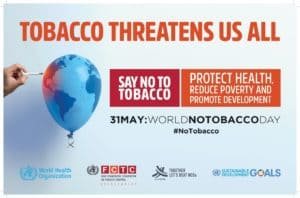This post was written by our partner LAMSA.
In 1988, the World Health Organization Assembly passed Resolution WHA42.19, calling for an around the world celebration on May 31, every year, a World No Tobacco Day, to “draw global attention to tobacco epidemic and the preventable death and disease it causes”.
Each year for the occasion, the World Health Organization (WHO) chooses a new theme, to highlight the threat of tobacco, smoke and second-hand smoke on global health, the burden of non-transmissible chronic diseases (cardio-vascular diseases, cancers and chronic obstructive pulmonary diseases), and the high rates of preventable deaths as well as the negative impact of tobacco on poverty and environment. Youth and women were at the heart of the WHO campaigns in 2008 and 2010 respectively, the two groups being a primary target of the tobacco industry, in particular in developing countries.
The theme for World No Tobacco Day, May 31 2017, is “Tobacco-a threat to development”
This year, as tobacco control has been enshrined in the Sustainable Development Agenda, the campaign will demonstrate “the threats that the tobacco industry poses to the sustainable development of all countries, including the health and economic well-being of their citizens.”

How can you contribute to make a sustainable, tobacco-free world?
- Commit to never taking up tobacco products
- Quit the habit
|
|
Tobacco smoking: A global epidemic
Although the overall smoking rate has declined in developed countries, higher rates of smoking persist among certain populations that have lower income, lower level of education, a serious mental illness or are LGBTQ. The rate of smoking is also high and still increasing in low and middle-income countries, in particular in Africa and the MENA region, where over 60% of adults are smokers. These regions are still struggling to implement indoor smoking ban laws. They are also the target of the tobacco industry, with a special focus on youth (as young as 16 years) and women, turning them into clients for life. Thus, smoking still represents the biggest global public health issue.
Being the first preventable cause of mortality, smoking still kills worldwide 50% (1 over 2 smokers) of its consumers (6 million/year, including 600,000 passive smokers), and is the principal risk factor of the non-transmissible chronic diseases (NCD, cause of 60% of total mortality). Moreover, beside the many physical health pathologies (cancers, chronic obstructive pulmonary diseases, children’s asthma, sudden infant death, infertility…), new studies suggest there might be a link between smoking and certain mental illnesses, in particular psychosis and schizophrenia.
Tobacco Control in Lebanon: Status quo
While globally, governments are taking additional tobacco control measures, like for example the last regulation in the UK, which came into force on May 20, 2017, imposing standardized and repulsive green packets, Lebanon is still ignoring the issue. No new measure has been adopted lately by the Lebanese government, in the Tobacco Control strategy.
Since signing the WHO Framework Convention on Tobacco Control (FCTC) on March 4, 2004, Lebanon adopted some valuable measures. The most important was the adoption, in 2011, of a new tobacco control law (Law 174), which bans smoking in indoor public places. Subsequently, the government adopted a number of decrees banning the advertising and promotion of tobacco products and imposing larger health warnings on the packets. An agreement has been also signed between the Ministry of Public Health and the Syndicate of Lebanese Actors, to ban smoking in Lebanese movies and comedies, because of its adverse impact, in particular on adolescents.
All those measures were adopted in coordination with the National Tobacco Control Program (NTCP), established in 2009 within the Ministry of Public Health. In 2015, the NTCP developed the first strategy on smoking cessation.
Lebanon’s Concept of letting go
The current situation is deceiving and alarming.
- Lebanon has the highest smoking prevalence (60% of adults) of all countries in the Eastern Mediterranean, including the highest prevalence (36, 9%) of Narguile smoking
- Two vulnerable groups are particularly at risk:
- Youth: Age of first cigarette smoking is as low as 11. 41, 9% of boys aged between 13 and 15 years old are smokers (Cigarettes, Narguile…)
- Women: 34% of adult women are also smokers (Cigarettes, Narguile…)
- In 2013, public compliance to the Law 174 was very high (69%).Today, compliance is lower (No data available) and the law is only partially respected.
- Despite legal age restrictions (18), tobacco products can be easily bought by teenagers.
- Taxes on tobacco products are still low, making them affordable, in particular for children and teenagers
- The market for counterfeit and illegal tobacco products is large and expanding, in part due to the Syrian conflict
- Narguile consumption is increasing, with common misunderstanding about its harm.
- Concerning treatment of tobacco dependence:
- Smoking cessation support is available only in some hospitals and clinics. However, since it is not covered by national or private insurances, it is neither accessible nor affordable for the vast majority of the population
- Nicotine Replacement Therapy is (partly) available in pharmacy, without a need for prescriptions. They are also not affordable for all
- There is no quit-line/help-line to discuss cessation with smokers
- The few NGOs working in the field are not receiving enough funds for smoking cessation services. Thus, their activities are limited and undertaken on a volunteer basis
- The National Tobacco Control Program (NTCP) of the Ministry of Public Health lacks the proper resources to address the issue. As a result, no serious measure has been undertaken to implement the strategy on smoking cessation developed in 2015.
In 2011, National law (Decision number 1/207) banned the import and sale of “e-cigarettes” (Decision number 1/207). This law has been reversed in 2015 (Decision number 877)
“E-cigarettes”, which vaporize liquid containing nicotine, could be a quitting tool for a short period
Other products, like the latest technology Heat-Not-Burn, which heat tobacco, should be reserved for smokers not willing to quit or unable to quit
Quit smoking by the validated Nicotine Replacement Therapy, should always be the first option
At this stage, and before their availability on the Lebanese market, it’s important to raise awareness among children and teen-agers, non-smokers and old smokers, concerning their use.
An “Inter-ministerial Substance Use Response Strategy for 2016-2021”, has been launched jointly by the Ministries of Public Health (and the NTCP), Social Affairs, Education and Higher Education, Interior and Municipalities in addition to Justice, as a response for substance use including tobacco. It is the first time that four ministries work together towards common goals in this field. This will hopefully contribute to positively impact public health in Lebanon.
